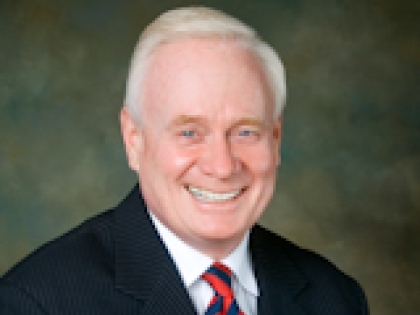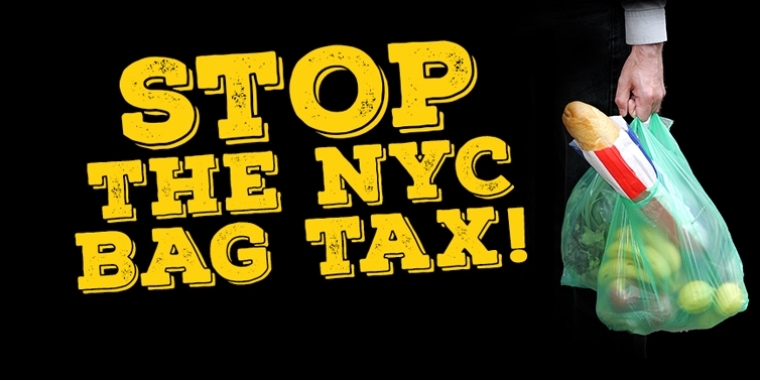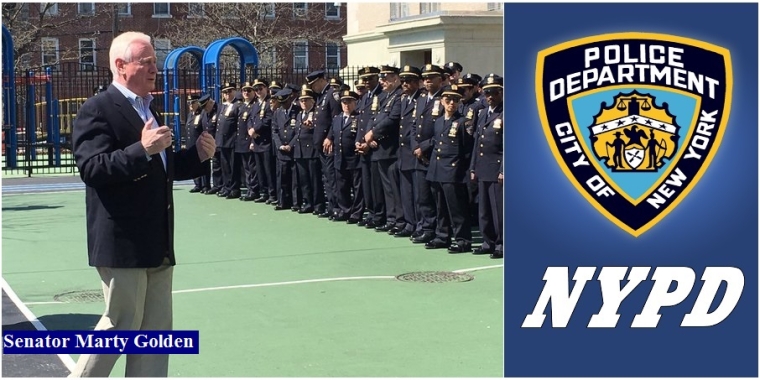
Analysis: $40 Million That Gov. Cuomo Seeks from MTA Could Add Bus & Rail Service, Reduce Crowding and Waits, and Lessen Pressure on Fares
Martin J. Golden
March 25, 2014
State Senator Martin Golden said, “I sponsored the Transit Funding Lockbox Act in the State Senate so to stand up for all those who ride the buses and trains and have been asked to pay more for less service. This legislation will guarantee that funds dedicated to support the Metropolitan Transit Authority’s commuter system, will actually be spent for such purposes and not get lost on the account of other State expenses. It is vital that this year's budget retains the $40 million for transportation purposes so to create greater financial integrity for the Metropolitan Transit Authority and end the days of simultaneous fare hikes and service reductions.”
NYPIRG Straphangers Campaign
Riders Alliance
FOR IMMEDIATE RELEASE: March 24, 2014
Contact: John Raskin (Riders Alliance), 646-369-8093
Gene Russianoff (NYPIRG), 917-575-9434
Analysis: $40 Million That Gov. Cuomo Seeks from MTA Could Add Bus & Rail Service, Reduce Crowding and Waits, and Lessen Pressure on Fares
Governor and Legislature Wrangle Over Transit Funding; Issue to be Decided This Week, as State Budget Negotiations End
NEW YORK, NY—The Riders Alliance and the NYPIRG Straphangers Campaign released an analysis today detailing service improvements that could be made if the State Assembly and Senate are successful in blocking Governor Cuomo’s proposed $40 million raid on public transit funds in the State budget.
The organizations outlined an example of potential transit uses for $40 million, using the MTA’s own estimates for cost savings achieved during the massive 2010 service cuts. They concluded that – if the Assembly and Senate restore the Governor’s proposed $40 million cut to a State account of dedicated transit funds – the MTA could make such improvements as:
Subways
· Restore mid-day, nighttime and weekend service that was reduced on the 1, 7, A, F, J, L and M lines in 2010, creating shorter waits for 300,000 riders every weekday and 285,000 riders every weekend ($3.1 million)
· Add 20% more morning rush hour service on the notoriously infrequent and crowded C train ($1 million)
· Restore G train service to Forest Hills--71st Avenue in Queens ($1.5 million)
· Restore W train one-seat service from Astoria to Lower Manhattan ($3.4 million)
Buses
· Add four new local daytime and three new weekend routes in the Bronx ($4.2 million)
· Add three new local bus routes and implement weekend hours for three weekday-only routes in Brooklyn ($4.7 million)
· Add three bus routes and implement weekend hours for two weekday routes in Manhattan ($4.7 million)
· Add three new bus routes with weekday and weekend hours in Queens ($6.9 million)
· Add three new weekend routes, and three new peak hours routes in Staten Island ($3 million)
Commuter Rail
· Add 6 new LIRR rush hour trains every weekday ($2.2 million)
· Add 10 new off-peak weekday LIRR trains ($0.4 million)
· Add 10 new LIRR trains every weekend day ($0.3 million)
· Add cars to Metro-North trains to reduce crowding on the Harlem, Hudson and New Haven lines ($2.7 million)
· Add two daily Metro-North trains each to the Harlem, Hudson and New Haven lines ($1.9 million)
Fares
The groups pointed out that the funds could instead be used to reduce MTA plans to increase the fare in 2015 and 2017. They noted that the MTA had initially warned it would raise by 8.4%, twice the rate of inflation. In response to widespread criticism, the agency then said it would raise fares by 4% every two years, about half their initial rate. However, in recent weeks, the MTA has again warned that its financial problems may cause a higher fare increase.
The analysis used recent MTA budget documents, including cost savings descriptions for service reductions made in 2010, to estimate what could be achieved for one year of service with $40 million. In this year’s budget, Governor Cuomo has proposed to raid $40 million from a pot of dedicated transit funds in order to pay debt service on bonds that the State had originally promised to support. Both the Senate and the Assembly rejected the Governor’s proposed raid in their respective one-house budget resolutions. The final budget is expected to be negotiated this week and is due by the end of March.
John Raskin, Executive Director of the Riders Alliance, said, “This money could be used to relieve crowding on buses and trains and give many riders shorter commutes. But many improvements will only be possible if the Assembly and Senate stand strong and reject the governor's raid on dedicated transit funds."
Gene Russianoff, Staff Attorney for the NYPIRG Straphangers Campaign, said, “$40 million could make a real difference in the commuting lives of hundreds of thousands of transit riders. They are hoping that Albany will come to their aid.”
State Senator Martin Golden said, “I sponsored the Transit Funding Lockbox Act in the State Senate so to stand up for all those who ride the buses and trains and have been asked to pay more for less service. This legislation will guarantee that funds dedicated to support the Metropolitan Transit Authority’s commuter system, will actually be spent for such purposes and not get lost on the account of other State expenses. It is vital that this year's budget retains the $40 million for transportation purposes so to create greater financial integrity for the Metropolitan Transit Authority and end the days of simultaneous fare hikes and service reductions.”
State Senator Martin Malavé Dilan said, “New York’s infrastructure continues to reap what decades of dedicated fund raids have sowed. Almost every mile of road, track and bridge across the state shows the signs of this untenable practice, including New York City’s mass transit system. The subways and trains are overcrowded. Bus routes are few and far between due to budget cuts in recent years; and the core infrastructure is still reeling from the effects of Superstorm Sandy. A $40 million raid on dedicated transit funding will only exacerbate these issues and set a terrible precedent.”
State Senator Brad Hoylman said, "It's short-sighted to divert dedicated MTA funding towards other purposes. This report shows how reinvesting in our transit infrastructure using this funding could increase service, reduce crowding and fare pressure, and overall improve the state of good repair for the system, which in the long run will save taxpayers money."
State Senator Liz Krueger said, "In 12 years in Albany, I've found governors and legislative leaders are lightning-quick to claim our troubled capitol has turned over a new leaf, but glacially slow when it comes to ending the budgetary tricks, gimmicks, and bad habits that got us in trouble in the first place. Nowhere is this more evident than transit funding, which the governor has once again proposed to raid. Our mass transit system is the engine that drives the entire downstate economy, from Long Island to the city and the Hudson Valley -- raiding this funding is self-destructive and nonsensical."
State Senator Daniel Squadron said, "Our subway system moves millions of people every day -- yet, as any rider can tell you, it is aging and needs help. We must maintain and improve service and do everything possible to prevent fare increases, and the best way to do that is to protect every dollar intended for transit. I'll continue fighting to fully fund our transit system, and I look forward to working with my colleagues and transit advocates like the Riders Alliance."
State Assemblyman Michael Benedetto said, “Myself and many of my Assembly colleagues believe that when the money is available it should be used to provide more services, or hold down the fare, not diverted for other purposes. We ask that the governor realize how important this is to our mass transit ridership.”
State Assemblyman David Buchwald said, “I am pleased that the Assembly budget proposal rejects the plan to divert $40 million in MTA operating funds to pay MTA debt service. During the past years, our riders have dealt with continual fare increases and slashed services. Taking away money that is meant to invest in our transportation system is not the right thing to do – the MTA riders deserve a commitment to improved services and a limit to fare increases.”
State Assembly Member Karim Camara said, "This report makes it crystal clear: $40 million can make a real difference in the commutes of New Yorkers. The B46 on Utica Avenue that runs through Crown Heights is the second busiest bus route in New York City. It’s about time the MTA started giving it the resources such a route warrants. A small percentage of that $40 million could go a long way in alleviating overcrowding and delays. New Yorkers and the MTA rank and file simply deserve better."
State Assemblywoman Sandy Galef said, “I will continue to strongly oppose diverting dedicated funding for transit to other purposes. Now more than ever our rail systems need a committed source of funding to provide necessary rail safety improvements. Metro-North has experienced an unprecedented number of accidents in the past year, and every dollar allocated to their funding will help improve safety measures. This state money could be used for a Positive Safety Control system, which could prevent future accidents like the one last year which resulted in tragedy for my constituents.”
State Assembly Member Richard Gottfried said, "New York should be restoring service on the public transit system and keeping it affordable. The transit system is key to creating the region’s wealth. That wealth should support the transit system. It's wrong to use a financial shell game to take away transit funds to pay for tax cuts for wealthy interests."
State Assembly Member Micah Kellner said, "New Yorkers can't afford for the MTA to be condemned to a slow death by a thousand cuts. The Riders Alliance report vividly illustrates the critical services and infrastructure that will be short-changed if $40 million is cut from the MTA budget, and why we need to fight hard to preserve this vital transit funding."
State Assemblyman Joseph Lentol said, "We must maintain full funding for our mass transit system because it is the key to the economic health and well being of our City. I know that right now my neighborhood is booming, but if we don't work to improve the mass transit that serves it, that economic prosperity will be in jeopardy. It's clear our system requires significant infrastructure repairs, improvements and expansion. That comes from increased ridership, from everyday use and from the devastating storms we have experienced that caused massive damage and pointed out the system's weaknesses. We need to address these needs and move forward in our efforts to maintain a transit system that is up to the job of moving people around our City."
State Assemblywoman Nicole Malliotakis said, "It is critical that the state budget provides adequate funds for transportation and does not redistribute transit dollars to pay for other initiatives. This unfortunately occurred in 2010 and, as a result, bus service was eliminated while fares and tolls increases. Much of the service cut at the time has since been restored but we're still fighting to get Brooklyn's B37 and Staten Island's X18 restored. Losing an additional $40 million would make this even more difficult. The threat of having dedicated transit funds diverted is the reason why the state legislature has passed a lock box legislation. Unfortunately, it was twice vetoed by the Governor."
State Assemblyman Walter Mosley said, "Our transit system is at the heart of what sustains our thriving economy and attracts people to the cultural and entertainment core. We must preserve the $40 million in transit funding, and in so doing work to restore previously cut transit services and dramatically improve conditions on Metro-North and LIRR train lines. We cannot afford to balance the MTA's budget on the backs of hard working New Yorkers. I stand with my colleagues and a strong coalition of public transportation advocates to rally for these desperately needed funds."
State Assemblyman Steve Otis said, "I am very pleased to have been part of the effort to restore this funding in the Assembly budget resolution and am hopeful that the funds will be included in the final budget. Mass transit needs additional funding to improve service reliability and safety."
State Assemblyman Dan Quart said, “Protecting public transportation is always one of my highest priorities in Albany. This $40 million can make a real difference for straphangers and should only be used for mass transit.”
State Assemblyman Edward Ra said, "Mass transit is crucial to Long Island residents. We must do more, not less, to ensure less crowding and better access to mass transit. As we work to pass a budget this week, ensuring proper funding for public transportation is one of my top priorities."
State Assembly Member Linda B. Rosenthal said, “Balancing the budget by raiding the MTA’s funds needlessly punishes the New Yorkers and commuters who will suffer the service cuts and fare hikes that follow. An affordable, effective transit network is the lifeblood of any major city, and the possibility of restoring more of the critical bus lines and other services cut in 2010 makes the pressing need for this funding even clearer. Continually using the MTA as the State’s piggybank jeopardizes the City’s goal of shifting people from cars to transit.”
State Assemblywoman Nily Rozic said, "This year's state budget must ensure key services for working and middle class New Yorkers. At a time of increasing ridership and longer commute times, our riders need enhanced, quality service--especially in outer-borough communities. That is why we cannot afford to sweep out $40 million in dedicated funding for mass transit."
State Assemblywoman Aravella Simotas said, "In recent years, MTA riders have been faced with service cuts, fare increases, and increased crowding and delays-- especially here in the growing community of western Queens. Given these continued problems, any funding dedicated to improving public transit must be used exclusively for that purpose, and not raided to the detriment of millions of commuters."
State Assemblyman Matthew Titone said, “We need to be investing in our transportation systems, not depleting them. The Assembly budget plan rejects the executive proposal to divert $40 million in MTA operational funds to pay MTA debt service. This money was dedicated for mass transit needs and shouldn’t be used for anything else.”
State Assemblyman Weisenberg said, "I strongly support the Assembly’s budget resolution, which fully restores the Governor’s proposed cuts to the MTA. The availability of mass transit is essential to the many commuters in my district who rely on the MTA to get to and from their jobs. I will continue advocating for the full restoration of funding during budget negotiations,"
State Assembly Member David I. Weprin said, "The proposal to deprive the transit system of $40 million is a nonstarter. Ridership of the New York City subways alone exceeds 5,000,000 people on the average weekday. This budget raid would only necessitate further, more dramatic fare raises for all commuters and straphangers. I absolutely believe that we in the State Assembly must negotiate to find funds through other channels. The transit riding public should not be the government's default cash-cow."
William Henderson, Executive Director of the Permanent Citizens Advisory Committee to the MTA, said, “Almost four years after the MTA’s damaging cuts to bus, commuter rail, and subway service, riders are still impacted by these reductions. The MTA has struggled to find resources to restore these cuts, but this analysis shows that protecting dedicated MTA funding can result in a major benefit to riders.”
Veronica Vanterpool, Executive Director of the Tri-State Transportation Campaign, said, “Since 2008, we’ve been reeling from the impacts of service cuts and fare increases. It’s time to be thinking about how transit service can be expanded and the fare can be stabilized. But, these are only pipe dreams if this diversion occurs.”
Eric Alexander, Director of Vision Long Island, said, "Keeping transit dollars directed towards providing LIRR train service and other support is precisely what the public expects. In order to grow our economy and transit oriented development our NYS tax dollars need to support reliable, stable transit service."
Share this Article or Press Release
Newsroom
Go to Newsroom


